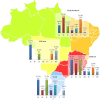Streptococcus agalactiae in Brazil: serotype distribution, virulence determinants and antimicrobial susceptibility
- PMID: 24919844
- PMCID: PMC4061772
- DOI: 10.1186/1471-2334-14-323
Streptococcus agalactiae in Brazil: serotype distribution, virulence determinants and antimicrobial susceptibility
Abstract
Background: Group B Streptococcus (GBS) remains a major cause of neonatal sepsis and is also associated with invasive and noninvasive infections in pregnant women and non-pregnant adults, elderly and patients with underlying medical conditions. Ten capsular serotypes have been recognized, and determination of their distribution within a specific population or geographical region is important as they are major targets for the development of vaccine strategies. We have evaluated the characteristics of GBS isolates recovered from individuals with infections or colonization by this microorganism, living in different geographic regions of Brazil.
Methods: A total of 434 isolates were identified and serotyped by conventional phenotypic tests. The determination of antimicrobial susceptibility was performed by the disk diffusion method. Genes associated with resistance to erythromycin (ermA, ermB, mefA) and tetracycline (tetK, tetL, tetM, tetO) as well as virulence-associated genes (bac, bca, lmb, scpB) were investigated using PCR. Pulsed-field gel electrophoresis (PFGE) was used to examine the genetic diversity of macrolide-resistant and of a number of selected macrolide-susceptible isolates.
Results: Overall, serotypes Ia (27.6%), II (19.1%), Ib (18.7%) and V (13.6%) were the most predominant, followed by serotypes IV (8.1%) and III (6.7%). All the isolates were susceptible to the beta-lactam antimicrobials tested and 97% were resistant to tetracycline. Resistance to erythromycin and clindamycin were found in 4.1% and 3% of the isolates, respectively. Among the resistance genes investigated, tetM (99.3%) and tetO (1.8%) were detected among tetracycline-resistant isolates and ermA (39%) and ermB (27.6%) were found among macrolide-resistant isolates. The lmb and scpB virulence genes were detected in all isolates, while bac and bca were detected in 57 (13.1%) and 237 (54.6%) isolates, respectively. Molecular typing by PFGE showed that resistance to erythromycin was associated with a variety of clones.
Conclusion: These findings indicate that GBS isolates circulating in Brazil have a variety of phenotypic and genotypic characteristics, and suggest that macrolide-resistant isolates may arise by both clonal spread and independent acquisition of resistance genes.
Figures


References
Publication types
MeSH terms
Substances
LinkOut - more resources
Full Text Sources
Other Literature Sources
Medical

